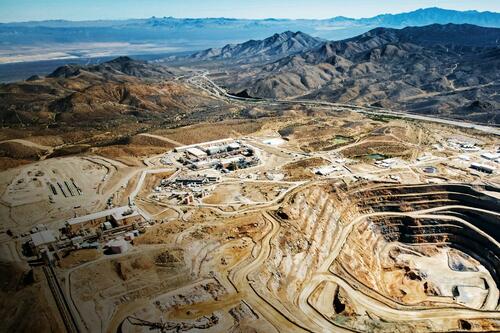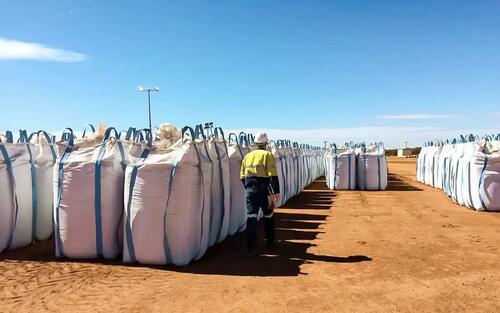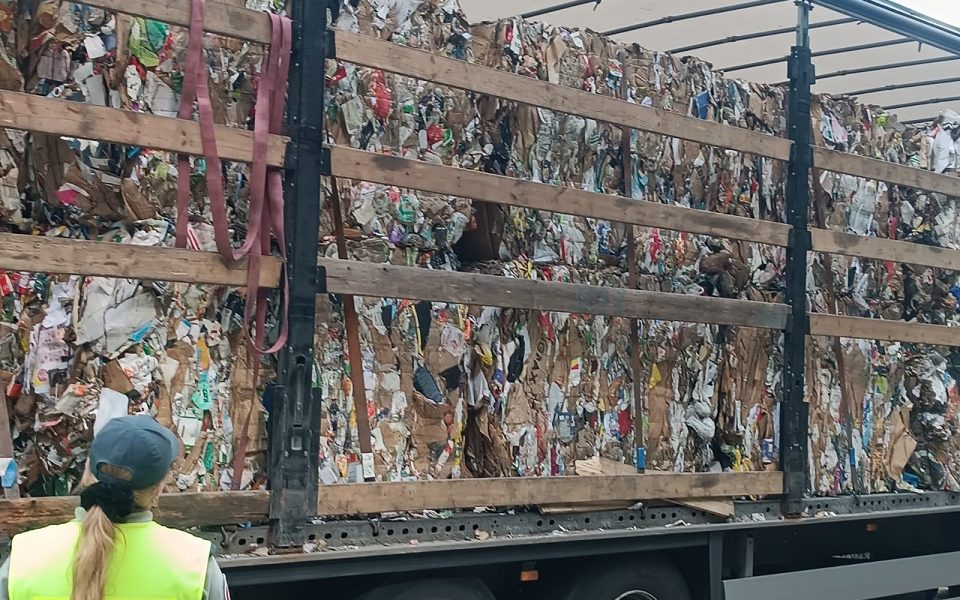
США могут производить редкие земли, если Китай прекратит экспорт, но есть улов
Автор John Haughey via The Epoch Times (выделено нами),
Потребуется до пяти лет, чтобы разработать внутреннюю цепочку поставок, чтобы заменить глобальную монополию Китая на переработку редкоземельных элементов в материалы, необходимые для производства всего, от iPhone до истребителей F-35.
 Вид с воздуха на шахту MP Materials в Маунтин-Пасс, Калифорния, в 2024 году. MP Материалы через AP
Вид с воздуха на шахту MP Materials в Маунтин-Пасс, Калифорния, в 2024 году. MP Материалы через APВ то время как Соединенные Штаты имеют большинство из 17 редкоземельных элементов и 50 критических минералов под землей, у них нет промышленных мощностей для их переработки в обработанные металлы и магниты, по словам Мелиссы «Мел» Сандерсона, члена совета директоров American Rare Earths и сопредседателя Института критических минералов.
"В настоящее время в Соединенных Штатах у нас есть производители нулевых магнитов.— сказал Сандерсон The Epoch Times.
Она сказала, что именно поэтому Китай ввел экспортные ограничения на семь «тяжелых» редкоземельных элементов 4 апреля в ответ на объявление президента Дональда Трампа 2 апреля о тарифах, которые увеличили сборы на импорт Китая. После повышения тарифов «око за око» Соединенные Штаты в настоящее время взимают китайский импорт на 145 процентов, а электроника на данный момент освобождена.
"Я, конечно, надеюсь, что, поскольку администрация работает в этой критической области — без каламбура, это критическая область — они понимают, что есть этот пробел в уязвимости, разрыв в четыре-пять лет, независимо от того, как вы на это смотрите, с точки зрения наращивания внутреннего производства.- сказал Сандерсон.
Приказ Трампа от 2 апреля дает министру торговли Говарду Лютнику 180 дней, чтобы предложить, как федеральное правительство может помочь разработать «круговую» внутреннюю цепочку поставок редкоземельных элементов.
Президент также обдумывает приказ, разрешающий глубоководную добычу и коммерческое накопление.
Что бы ни делала администрация, с достаточным количеством разрешений на реформы, дерегулирование и стимулирование государственного и частного секторов, промышленность ответит, сказал экономист Антонио Грейсффо.
"Короткий ответ заключается в том, что если Китай запретит продажу редкоземельных минералов в Соединенные Штаты навсегда, это позитивная вещь, потому что это заставит Соединенные Штаты найти решение.- сказал он.
Аналитик, который пишет о торговых отношениях США и Китая для The Epoch Times, Грейсффо сказал, что есть «тонны решений» для создания внутренней цепочки поставок редкоземельных элементов, включая продолжающиеся переговоры с Украиной.
 Министр торговли Говард Лютник уходит после того, как президент Дональд Трамп подписал указы о введении тарифов на импортные товары во время мероприятия в Розовом саду в Белом доме 2 апреля 2025 года. Трамп объявил о введении новых тарифов на импорт из стран, включая Китай, Японию и Индию. Эндрю Харник / Getty Images
Министр торговли Говард Лютник уходит после того, как президент Дональд Трамп подписал указы о введении тарифов на импортные товары во время мероприятия в Розовом саду в Белом доме 2 апреля 2025 года. Трамп объявил о введении новых тарифов на импорт из стран, включая Китай, Японию и Индию. Эндрю Харник / Getty Images"Абсолютно мы можем преодолеть проблему", - сказал он. В долгосрочной перспективе будет намного лучше, если Китай отрежет нас. И, конечно, промышленность найдет выход. "
С этим согласен профессор экономики Школы шахт Колорадо Ян Ланге. «Я на оптимистической стороне», — сказал он.
Ланге сказал, что есть заменяющие материалы для семи ограниченных редкоземельных элементов, и некоторые производители говорят ему, что они выживут без них.
Он задал вопрос, сможет ли Китай сохранить свои ограничения на экспорт редкоземельных элементов, потому что американские отрасли являются их крупнейшим рынком.
"Посмотрим, будет ли это реальный или просто еще один обруч, чтобы прыгнуть через него.— сказал Лэнг The Epoch Times. «В последние пару лет мы медленно наращиваем цепочку поставок.
«Мы приближаемся к тому, чтобы что-то получить здесь, в Соединенных Штатах. "
Но термин «близкий» является относительным, когда речь идет о добыче и переработке полезных ископаемых, где для утверждения предлагаемых проектов обычно требуется от 10 до 20 лет.
Долгий путь ?
базирующийся в Австралии американский Редкие Земли являются одной из волн стартапов в Соединенных Штатах, занимающихся редкоземельной и критической добычей полезных ископаемых.
Он также обработает диспрозий и тербий, два из семи ограниченных «тяжестей», построив нефтеперерабатывающий завод возле шахты Halleck Creek за пределами Уитленда, штат Вайоминг. Диспрозий используется в магнитах, встроенных в двигатели и генераторы для ветряных турбин, электрических транспортных средств и стержней управления ядерным реактором. Тербиевые соединения используются в электронике, полупроводниках и флуоресцентном освещении.
Компания, которая также имеет шахту в Аризоне, получила грант в размере 7,1 миллиона долларов от Вайоминга и письмо о процентах на сумму до 456 миллионов долларов в долговом финансировании от Экспортно-импортного банка США для производства того, что, по ее словам, является 20-летним запасом ключевых редкоземельных элементов, включая диспрозий и тербий.
Кроме того, в Вайоминге Ramaco Resources закладывает фундамент на месторождении редкоземельных элементов весом 1,5 миллиарда тонн и пилотном перерабатывающем заводе на своем руднике Брук. Компания Rare Element Resources начала «операции по обработке и разделению собственности» на демонстрационном заводе Bear Lodge в Аптоне.
США, базирующиеся в Оклахоме Компания Rare Earths, которая в этом году открывает завод по производству «неомагнита», произвела свой первый образец оксида диспрозия из своего рудника Round Top, штат Техас, в этом году и обработала его на своем исследовательском заводе в Пшеничном хребте, штат Колорадо.
Ucore Rare Metals разрабатывает комплекс стратегических металлов Луизианы в Александрии с государственными стимулами в размере 20 миллионов долларов, а Energy Fuels, уранодобывающая компания, обрабатывает моназитовые пески для добычи редкоземельных элементов на своем заводе White Mesa в Юте.
Оба являются канадскими компаниями.
Двумя наиболее известными операторами редкоземельных элементов в Соединенных Штатах являются австралийская компания Lynas Rare Earths, крупнейший в мире разработчик редкоземельных элементов за пределами Китая, и базирующаяся в Лас-Вегасе MP Materials Corp.
 Работник Lynas Corp проходит мимо мешков редкоземельного концентрата, ожидая отправки в Малайзию, на горе Уэлд, к северо-востоку от Перта, Австралия, 23 августа 2019 года. Мелани Бертон / Reuters
Работник Lynas Corp проходит мимо мешков редкоземельного концентрата, ожидая отправки в Малайзию, на горе Уэлд, к северо-востоку от Перта, Австралия, 23 августа 2019 года. Мелани Бертон / ReutersОба имеют решающее значение в переработке редкоземельных элементов для Министерства обороны США, которое находится на полпути к пятилетнему плану по созданию «устойчивой цепочки поставок от мин до магнитов» для поддержки своих потребностей к 2027 году.
Дочерняя компания Lynas Rare Earth Lynas USA получила $258 млн в 2023 году на строительство завода по коммерческому разделению площадью 150 акров в Сидрифте, штат Техас, для обработки тяжелых редкоземельных элементов, таких как диспрозий и тербий.
В январе Пентагон заявил, что удвоил свой первоначальный проект, выходящий за рамки военных требований, чтобы «укрепить устойчивость цепочки поставок для ... растущей высокотехнологичной промышленности, а также ... потребностей национальной безопасности». "
В 2022 году Министерство обороны США выделило MP Materials $35 млн на строительство перерабатывающего завода в Маунтин-Пассе в Калифорнии.
В 2024 году он получил федеральный налоговый кредит в размере 58,5 миллионов долларов на строительство первого в стране полностью интегрированного завода по производству редкоземельных магнитов в Форт-Уэрте, штат Техас, для двигателей электромобилей GM.
В 2024 году MP Materials достигла рекордно высокого уровня производства в США на Маунтин-Пасс, доставив более 45 000 метрических тонн оксидов редкоземельных элементов и рафинированных продуктов.
Производство включало в себя рекорд США в 1300 тонн оксида неодима-празеодима, ключевых элементов в «постоянных магнитах», которые сохраняют свою магнитную силу в течение десятилетий.
"Эта веха знаменует собой важный шаг вперед в восстановлении полностью интегрированной цепочки поставок редкоземельных магнитов в Соединенных Штатах.», — сказал генеральный директор и основатель MP Materials Джеймс Литинский в январе.
«Мы достигли значительного переломного момента для конкурентоспособности парламента и США в жизненно важном секторе. "
Тем не менее, как Lynas Rare Earth, так и MP Materials производят больше редкоземельной руды, чем они могут обрабатывать. Чтобы поддерживать операции, они должны экспортировать большую часть того, что они раскапывают.
«MP в основном является крупнейшим оффшорным поставщиком редкоземельной руды в Китае», - сказал исполнительный председатель Института критических минералов Джек Лифтон, отметив, что китайская Shanghai Resources Industrial & Trading Co. купила 32 000 тонн на сумму 350 миллионов долларов у MP Materials в 2024 году.
MP Materials не отвечала на телефонные звонки или запросы на интервью по электронной почте.
Читайте остальное здесь...
Тайлер Дерден
Thu, 04/24/2025 - 23:00

















![Radzyń Podlaski. Poszukiwany właściciel telefona [ZDJĘCIA]](https://static2.slowopodlasia.pl/data/articles/xga-4x3-radzyn-podlaski-poszukiwany-wlasciciel-smartfona-zdjecia-1756210897.jpg)
